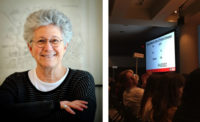AIA Passes Equity Resolution: Now What?

On May 16, thousands of delegates of the American Institute of Architects (AIA) filed into a hall in the Georgia World Congress Center in Atlanta to vote on a series of 15 resolutions set forth for approval. One of the most talked-about items on the ballot was Resolution 15-1, also known as Equity in Architecture, a measure sponsored by AIA San Francisco and AIA California Council that called for the Institute to take definitive measures to close the gap in underrepresented populations—including women and minorities—“to move the profession forward.”
“The Institute is asked to develop an ongoing program to assess data, set a plan of action, track progress, and report on results,” the resolution’s statement of intent read. “Now more than ever is the time for action both from grassroots and Institute leadership.”
The motion’s sponsors got their wish: the measure passed with overwhelming support, with 4,117 delegates voting in favor.
If such initiatives sound like well-trodden turf, it’s because they are; this isn’t the first attempt by the AIA to increase diversity in the field—take 2008’s Gateway Commitment to increase demographic representation, or the adoption of a diversity statement in 2012. These endeavors, proponents of Resolution 15-1 note, have yielded disappointing results. Women only represent 18 percent of licensed AIA architect members while minorities comprise a dismal 13 percent, numbers that have shifted little over the years.
So what’s different this time around?
“Every once in a while there is a rally cry to do something,” says Rosa Sheng, who drafted the resolution and is a senior associate at Bohlin Cywinski Jackson. “[Past measures] have been a wish list of things, but there has been no implementation, no clear path, and no data. Our goal is to get the data to show what is currently happening.”
In order to ensure this initiative’s success, the resolution’s sponsors call for the AIA to look outside of the field for expertise and establish a commission of experts from fields as diverse as academia and business to devise a course of action to produce concrete, measurable results, rather than a generic, overarching statement of intent.
Sheng has been a vocal supporter of increasing women’s role in the profession for years. The architect, along with Lilian Asperin-Clyman of WRNS, Saskia Dennis-van Dijl of Cameron MacAllister Group, Helen Wong of AIASF, and Annelise Pitts of Bohlin Cywinski Jackson, spearheaded a series of symposiums called the Missing 32% Project, which focused on retaining female talent in the profession. Last year, the organization released their Equity in Architecture Survey, which yielded bleak results, including salary gaps and alarming dropout rates for women in architecture leadership positions.
The organization is now rebranding itself as Equity by Design. To raise awareness before the vote at the AIA convention, the organization hosted a hackathon (think spirited discussion groups, in lieu of JavaScript and Red Bull) with breakout sessions touching on topics such as hiring and retention, mentorship, and work/life balance.
The resolution is an important step in the right direction, Sheng acknowledges, but change will be incremental. “The aspiration is some kind of outcome to report for the convention next year. It’s ambitious, but we’d like to at least give a summary of all that has been learned and all that has been collected. There might be another resolution next year,” she says.
Sheng will also be presenting Equity by Design’s findings at a TEDx discussion in Philadelphia on June 11.


